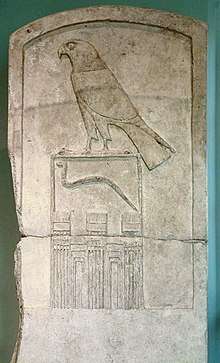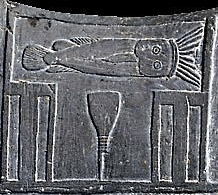Serekh
A serekh was a specific important type of heraldic crest used in ancient Egypt. Like the later cartouche, it contained a royal name.
| Serekh in hieroglyphs | |||||
|---|---|---|---|---|---|
srḫ serekh facade (of the palace) | |||||
 | |||||
Appearance
A serekh was an ornamental vignette combining a view of a palace facade and a plan (top view) of the royal courtyard. The word "serekh" derives from the Egyptian word for "facade". Different serekhs on different types of object display countless variations of the facade decor in its complexity and detail. It seems that no strict artistic rules for the design of the serekh itself existed.[1][2][3]
History
As already mentioned, the serekh first appears as an ornamental miniature during the late Gerzeh culture, when it was used as a royal crest only. From the Old Kingdom period onward, the first uses of the full written word appear in old papyri.[1][2][3]
Use
A serekh was normally used as a royal crest, accentuating and honouring the name of the pharaoh. Its use can be dated back as early as the Gerzeh culture (c. 3400 BC.). The hieroglyphs forming the king's name were placed inside a rectangular extension atop the serekh, which represented the royal courtyard. Additionally, the falcon of the god Horus, or in a few cases the Set animal, topped the serekh, showing the celestial patron of the named king.[1][2][3]
If the word "serekh" was written in full letters (as shown in the infobox above), sometimes accompanied by a miniature of the serekh, it could also be used in text.[1][2][3]
See also
References
- Jürgen von Beckerath: Handbuch der ägyptischen Königsnamen. Münchner Ägyptologische Studien. Bd. 49. Philipp von Zabern, Mainz 1999, ISBN 3-8053-2591-6, p. 7-9.
- Rolf Gundlach: Horus in the Palace: The centre of State and Culture in pharaonic Egypt. In: Rolf Gundlach, John H. Taylor: Egyptian royal Residences: 4. Symposium zur Ägyptischen Königsideologie (4th edition, London 2004). Harrassowitz, Wiesbaden 2009, ISBN 978-3-447-05888-9, p. 45–68.
- Toby A. H. Wilkinson: Early Dynastic Egypt: Strategy, Society and Security. Routledge, London 1999, ISBN 0-415-18633-1, p. 56-57, 201-202.
- Wengrow, David, The Archaeology of Ancient Egypt Cambridge University Press, ISBN 978-0-521-83586-2 p.207
| Wikimedia Commons has media related to Serekhs. |
